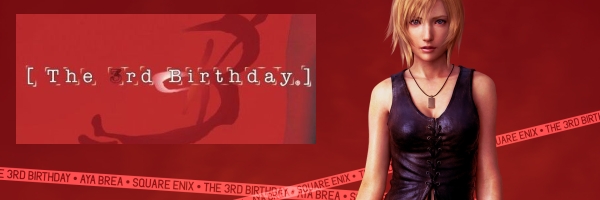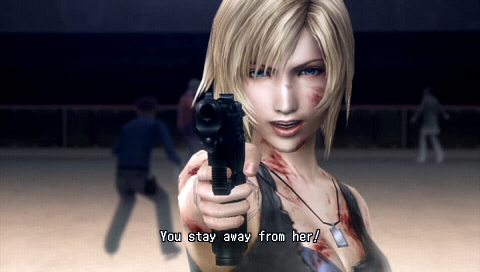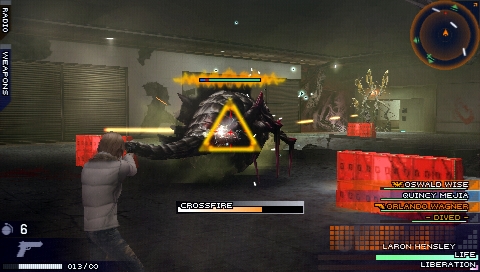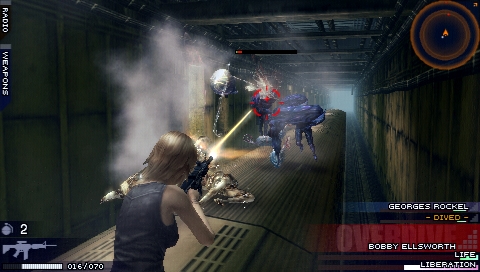
The Parasite Eve franchise got another addition to it with The 3rd Birthday for the PlayStation Portable. This third-person shooter reunites players with fan-favorite Aya Brea, whose tough demeanor has been replaced with scant clothing and helplessness. Changed is the title, and gone are the meatier parts of Parasite Eve‘s RPG elements, replaced instead with tactical action elements that feel jammed in like a square peg in a round hole. Repetitious gameplay and a convoluted plot, not to mention a complete deviation from the spirit of the series, make this birthday a forgettable one.
Platform: PSP
Publisher: Square Enix
Developer: Square Enix, Hexadrive
Genre: Tactical Role-Playing Shooter
Release Date: March 29, 2011
ESRB Rating: Mature
Fans of the Square Enix series, Parasite Eve, were thrilled to find out the franchise was getting another installment. It looked beautiful, and sounded promising. The story starts out in Manhattan on Christmas Eve in 2012, depicting a horrifying scene – people out enjoying the holiday spirit are interrupted by giant tentacles bursting from the ground, destroying buildings and killing people. These “Babels” bring more than death and destruction – they also bring monsters called the “Twisted.”
A special team is formed, the Counter Twisted Investigation (CTI), which specializes in studying and waging war on the Twisted and the Babels. Aya Brea was found shot in her wedding dress at St. Peter’s Cathedral and now has amnesia. She is brought in to CTI because she is able to transfer her soul to another’s body, which they call an “Overdive.” They use her – in 2013 – to Overdive into other people in the past to try to change the events of the past in order to make the future safe from these creatures.
Make sense? Don’t worry, it doesn’t get any better even if you play the game. This confusing and convoluted plot worsens as the game trudges on. Characters from previous games appear, like the Japanese scientist, Kunihiko Maeda, as well as Kyle Madigan. There’s also Aya’s little sister, Eve Brea, but whether or not she is her sister is confusing, as character’s comments and explanations for her vary – not to mention the explanations given in previous games. By the end, even though things were supposedly explained, I still wasn’t sure what exactly was going on. I feel like this should have been a stand-alone game, without trying – and failing – to shoehorn in an already established story.

While the story is confusing, with little context and failed attempts at clever deliveries, the gameplay is interesting but repetitious. Combat can be tricky. Aya gets to a room and usually must Overdive from one soldier to the next, staying out of reach of the Twisted and utilizing the best weapons and strategies to defeat them. Some require quick reflexes, others must be killed with a sniper rifle at long range, still others must be killed with awkward button mashing and fervent cursing.
Certain enemies can only be killed with specific weapons, so you have to figure out which soldier has the weapon you need and Overdive into him. Foes immediately latch on to whichever soldier you’re currently in, so you are a constant target. If the soldier with the weapon you need gets killed, you have to wait for another one to spawn, meaning you have to just keep Overdiving into other soldiers and hope they don’t all get killed before you have the chance to defeat the enemy with that specific weapon.
This may sound confusing, and it is at first, but it’s easy to learn. The real problem is that it starts to become repetitious and frustrating, especially when there’s only one weapon that can be used to take the enemy out. The one good thing was that I didn’t find myself running out of ammo too often, as with other survival horror games – though that in itself might be considered a failure on the game’s part, since the tension derived from constantly running out of ammo is a staple of the genre. In lieu of melee, you have unlimited ammo on guns like your initial handgun, which – while not the strongest gun – isn’t long range and can’t be depended on against harder foes.

Crossfire is another very useful ability Aya has. With Crossfire, Aya can concentrate her teammates’ fire specifically on one enemy. This is very helpful because the AI in this game can be absolutely useless. They often pop out of cover just in time to get shot right in the face, or don’t even bother hiding behind cover and stand stupidly out in the open, maybe shooting at an enemy, maybe not. Crossfire forces them all to stop chasing butterflies and take out the enemy you’re focused on, which, in my case, was usually whichever one was the most threatening at the time.
Aya can also use a third special ability while battling enemies, the Liberation Meter. The Liberation Meter fills as Aya fights, and when it’s full, she can unleash a powerful attack, during which she is invincible. This can be very effective when Aya is backed into a corner, and I often used it when desperately waiting for my backup to arrive. Using it leaves Aya weak and unable to react for several moments afterwards, though, during which she is vulnerable to attacks. However, this isn’t nearly as strong as Liberation was in the first game, and feels like a tacked-on attempt to create something fans will feel is familiar.
Overdive Kill was my favorite way to take out the Twisted. When an orange triangle appears on the enemy, hit the Triangle button to make Aya Overdive into the enemy and explode from within, causing considerable damage. This is often the only way to kill the bosses. It’s effective and brutal, but also leaves Aya confused and vulnerable for a moment – a much shorter amount of time than with Liberation, but still a moment in which she can’t dodge or fight back. When surrounded by enemies, this can be deadly, so be sure to be mindful of your surroundings when utilizing Overdive Kill.
The game has a decent weapon system, in which you can become more proficient in each type of gun, level them up, and unlock new attachments, which you pay for with your Bonus Points. Progression also unlocks different guns, and you can equip whichever ones you want, with the added bonus of being able to Overdive into other soldiers with other guns while you’re on the field doing missions. But the system was trying too hard to be something it couldn’t be – it felt too much like they took customizable options from a console shooter and added them to the already rich and useful weapon system present in previous Parasite Eve games.

You don’t have many armor options, and as you get hit more, your skimpy ripped jeans get turned into panty-sized cut-offs, showing off some of Aya’s curvier assets. As your clothing gets skimpier, your defense goes down, which is especially detrimental during boss fights. At the various save points at safe spots, as well as in between missions, you can use Bonus Points to repair your armor. Unlike the weapons options, this felt underwhelming. You didn’t really have any armor “choices,” and you could either be close to naked or fully clothed. While it was a useful way to market the game and an excuse to fill the instruction manual with racy shots of Aya, it was a waste of time.
The coolest option available to Aya is in the Over Energy chips which can be mapped on her DNA board. These chips, which are referred to as OE chips, can be obtained through Overdive and Overdive Kills. Chips include helpful pieces, which include abilities like healing, healing during crossfire, and raising Aya’s defense. There are also pieces that harm Aya as well, from slowing down her movement to bringing down her defense. These chips can be placed on Aya’s DNA board, and other DNA boards can be unlocked as you progress.
The DNA boards are set up as three-by-three grids, on which the chips can be placed however the player wants them to fall. Stacking up chips that are the same will add levels to them – if you have a Healing chip that is at level five, adding a level two will give you a level seven. But there’s a catch – laying chips down alone on a blank grid gives you predictable results, but layering the chips can get tricky. If the chips are different, you can get the chip you had down already, the new chip, or some mutation that brings an entirely new attribute – which could be positive or negative. Hitting Square lets you retry, and hitting Triangle brings up the list of what the results are. The levels will vary as well – adding a five to a two, as I said earlier, can result in a maximum of seven, but can actually be anywhere from one to seven.
The gameplay is intricate and involved and has a progressive leveling and weapons system, and the combat is frenetic and fast-paced and includes the Overdive system, which can be used to strategically defeat foes. While these could combine to make a terrific game, the incoherent storyline and forced references to previous games in the series make this game feel like it’s having an identity crisis. It was like they took a game they had already made, sprinkled in a few elements from Parasite Eve, slapped on a different title, and hoped the association would help sell more copies. As such, though it does have redeeming characteristics, the lukewarm package makes it a tepid and forgettable experience. I would actually recommend that fans of the series stay away from this game, and instead re-watch the opening cinematic for Parasite Eve – I enjoyed that more than the 18 hours I spent playing The 3rd Birthday.

Review Disclosure: A review copy of The 3rd Birthday was provided by Square Enix for the purposes of this review.







